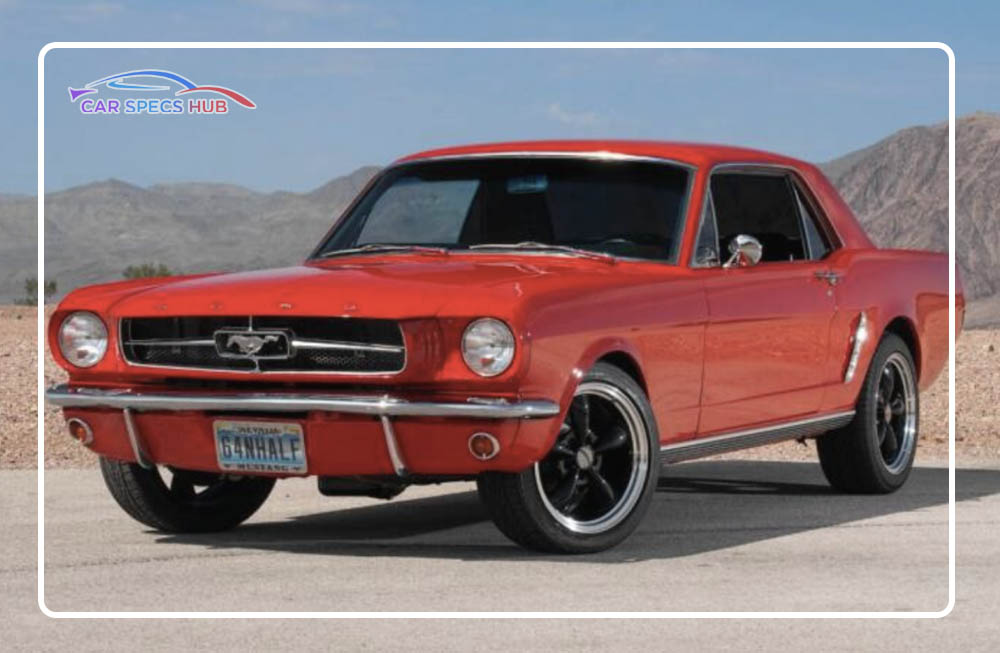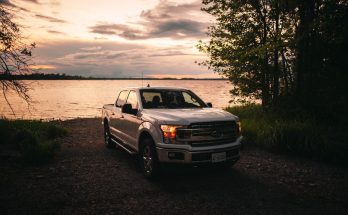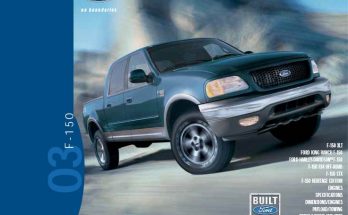
The 1965 Ford Mustang, introduced in April 1964 as an early 1965 model, revolutionized the automotive industry by creating the “pony car” segment. With its sporty design, affordable price, and extensive customization options, the Mustang became an instant success and an American icon. (wiki)
Overview
| Feature | Details |
|---|---|
| Production Years | 1964.5 to 1965 |
| Body Styles | Coupe, Convertible, Fastback |
| Platform | Ford Falcon-derived |
| Market Impact | Over 1 million units sold within 18 months |
Engine Specs and Features
| Feature | Details |
|---|---|
| Engine Options | Inline-6 170 ci (2.8L), 200 ci (3.3L) |
| V8 260 ci (4.3L), 289 ci (4.7L) | |
| Horsepower | 105-271 hp (depending on engine) |
| Torque | 156-312 lb-ft |
| Transmission Options | 3-speed manual, 4-speed manual, or 3-speed automatic |
| Fuel System | Single-barrel or 4-barrel carburetors |
| Cooling System | Water-cooled |
| Drive Type | Rear-wheel drive (RWD) |
Fuel & MPG
| Feature | Details |
|---|---|
| Fuel Type | Gasoline |
| Fuel Tank Capacity | 16 gallons |
| City MPG | 14-18 mpg |
| Highway MPG | 18-22 mpg |
| Combined MPG | 16-20 mpg |
Dimensions
| Feature | Details |
|---|---|
| Length | 181.6 inches |
| Width | 68.2 inches |
| Height | 51.0 inches |
| Wheelbase | 108 inches |
| Curb Weight | 2,445-2,815 pounds |
| Ground Clearance | 5.8 inches |
Safety Features
| Feature | Details |
|---|---|
| Brakes | Manual drum brakes (standard); front disc optional |
| Seat Belts | Standard front seat belts |
| Body Construction | Unibody with reinforced steel frame |
| Lighting | Sealed-beam headlights |
| Additional Features | Padded dashboard (optional) |
1965 Ford Mustang Interior Features
| Feature | Details |
|---|---|
| Seating Capacity | 4 passengers |
| Upholstery | Vinyl or optional leather |
| Dashboard | Sporty design with large, round gauges |
| Entertainment System | AM radio (standard); optional 8-track |
| Climate Control | Manual heating system; optional air conditioning |
| Storage | Compact trunk with fold-down rear seats (fastback) |
| Steering Wheel | Classic 3-spoke design |
| Interior Trim | Woodgrain (optional in Deluxe models) |
Exterior Features
| Feature | Details |
|---|---|
| Body Styles | Coupe, Convertible, Fastback |
| Headlights | Dual round sealed-beam headlights |
| Wheels | 13-inch or 14-inch steel wheels with hubcaps |
| Paint Options | Wide range of solid and metallic colors |
| Grille Design | Horizontal bar with galloping pony emblem |
| Bumpers | Chrome-plated |
| Windows | Manual crank-operated |
| Design Highlights | Long hood, short rear deck |
Current Price in U.S.
| Condition | Price Range |
|---|---|
| Excellent (Restored) | $30,000 – $80,000 |
| Good (Well-maintained) | $20,000 – $30,000 |
| Fair (Functional but Worn) | $12,000 – $20,000 |
| Poor (Needs Restoration) | $5,000 – $12,000 |
The 1965 Ford Mustang is a timeless classic that captured the hearts of car enthusiasts worldwide. Its sporty design, extensive customization options, and everyday practicality made it a game-changer in the automotive industry. Today, the 1965 Mustang remains a sought-after collector’s car, valued for its iconic status and historical significance.
How the 1965 Mustang Sparked the Pony Car Revolution
In the spring of 1964, a new automotive legend was born. The 1965 Ford Mustang didn’t just become a best-seller; it launched an entirely new segment of vehicles, forever changing American car culture. This iconic machine, often referred to as the “1964½ model” before its official 1965 designation, ushered in an era of performance, youth, freedom, and affordability, giving rise to the pony car phenomenon.
This article explores how the 1965 Mustang created a new automotive category, influenced countless designs, and fundamentally altered consumer perceptions of cars.
What Defines a “Pony Car”?
Before diving into the Mustang’s profound impact, let’s clarify the “pony car” definition.
A pony car is characterized by being:
- Compact
- Affordable
- Stylish
- Performance-oriented
Typically a 2-door coupe or convertible, pony cars are built on a standard car chassis but feature a distinctive long hood and short rear deck, emphasizing a sporty aesthetic.
Crucially, pony cars differ from full-sized muscle cars like the GTO or Charger. While muscle cars prioritized raw power for drag-strip dominance, pony cars democratized style and performance, making them accessible to everyday drivers, particularly the burgeoning youth market. The Ford Mustang was the undisputed pioneer of this segment.
The Genesis of the Mustang: Lee Iacocca’s Vision
The roots of the 1965 Mustang lie in Ford’s strategic foresight during the early 1960s. Recognizing the burgeoning influence of baby boomers entering adulthood, Ford aimed to tap into their desire for individuality, excitement, and affordability.
Lee Iacocca, the visionary Ford executive, championed the Mustang project with clear objectives:
- Sporty appearance
- Affordable pricing for the average American
- Extensive customization options
- Built on an existing platform (the Ford Falcon) to minimize costs
This ingenious use of the practical Ford Falcon chassis to create something entirely new proved to be a stroke of genius.
Revolutionary Design: Long Hood, Short Deck, Maximum Appeal
The design of the 1965 Mustang was groundbreaking. Its iconic long hood and short rear deck instantly conveyed speed and aggression, even at a standstill. The emblem of a galloping horse quickly became an enduring symbol. Ford initially offered three distinct body styles:
- Hardtop coupe
- Convertible
- 2+2 Fastback (introduced later in the 1965 model year)
Inside, the Mustang featured a driver-centric cockpit with bucket seats, a sporty steering wheel, and optional rally gauges. Despite sharing some components with the Falcon, the Mustang exuded a completely fresh and dynamic feel.
With a base price of approximately $2,300, the Mustang was incredibly accessible, putting stylish performance within reach for millions.
An Unprecedented Launch That Rocked the Industry
The Ford Mustang officially debuted on April 17, 1964, at the New York World’s Fair. Ford’s marketing blitz was a masterclass:
- Prime-time commercial spots across all three major television networks.
- Glossy, full-page magazine advertisements.
- Prominent Mustang displays in dealerships nationwide.
The immediate impact was staggering: over 22,000 Mustangs were sold on the first day alone. By the end of its inaugural model year (1965), Ford had sold nearly 418,000 units, dramatically exceeding even their most optimistic sales forecasts.
This was more than just a successful car launch; it was a cultural phenomenon.
Customization and Performance: “Choose Your Own Adventure”
One of the Mustang’s most compelling features was its extensive range of customization options. Buyers could opt for an economical 170 cubic-inch inline-6 engine or choose from more powerful options:
- 170 cu in I6 – 101 hp
- 200 cu in I6 – 120 hp
- 260 cu in V8 – 164 hp
- 289 cu in V8 – available in 200 hp, 225 hp, and the high-performance 271 hp (Hi-Po) variants.
With multiple transmission choices, axle ratios, and trim levels, the Mustang allowed buyers to tailor the vehicle to their budget and personal preferences, appealing to a broad demographic from students to working professionals.
Mustang GT & Fastback: Elevating Performance
In 1965, Ford introduced the GT package, significantly enhancing the Mustang’s performance credentials:
- Dual exhaust with chrome tips
- Fog lamps integrated into the grille
- Exclusive GT badging
- Disc brakes
- Performance suspension
When paired with the potent Hi-Po 289 V8, the GT transformed the Mustang into a formidable performance machine.
Concurrently, the Fastback model, with its distinctive sloping rear window and sporty silhouette, quickly became a favorite among racing enthusiasts. Its impact extended to motorsports, notably through legends like Carroll Shelby, who famously transformed the Mustang into the track-ready GT350.
The Pony Car Revolution: A Market is Born
The Mustang’s monumental success forced every major American automaker to respond, leading to the rapid proliferation of pony cars:
- Chevrolet Camaro (1967)
- Pontiac Firebird (1967)
- AMC Javelin (1968)
- Plymouth Barracuda (originally 1964, but redesigned in 1967 as a true pony car competitor)
- Dodge Challenger (1970)
These vehicles were not mere imitations; they were concrete proof that the Mustang had single-handedly carved out an entirely new and highly lucrative vehicle segment. By 1967, the term “pony car” was officially ingrained in automotive lexicon, describing this burgeoning category of sporty, affordable two-door coupes inspired by the original Mustang.
Cultural Icon: More Than Just a Car
The 1965 Mustang transcended the automotive world to become a bona fide pop culture icon. It featured prominently in movies, music videos, and became a ubiquitous presence in American garages. From Steve McQueen’s iconic Fastback in Bullitt to its presence in popular songs and the garages of celebrities, the Mustang represented something profound: freedom, youth, and self-expression. Unlike expensive European sports cars, the Mustang was an attainable dream for everyday Americans.
Enduring Appeal: Why the 1965 Mustang Remains a Collector’s Dream
Nearly six decades later, the 1965 Mustang continues to be one of the most sought-after classic cars. Its enduring appeal stems from:
- Timeless Design: Its aesthetics remain sharp and captivating even today.
- Mechanical Simplicity: Its straightforward engineering makes restoration and maintenance relatively easier.
- Vast Aftermarket Support: A wealth of reproduction parts and custom accessories are readily available.
- Vibrant Enthusiast Community: A large, passionate global community dedicated to the Mustang.
- Strong Collector Value: Especially for GT and Fastback models, ensuring solid resale value.
Beyond these practical aspects, the 1965 Mustang offers an unparalleled driving experience—light steering, a visceral V8 rumble, and an analog feel that harks back to a purer era of driving.
Mustang by the Numbers: A Phenomenal Success Story
The statistics underscore the Mustang’s unprecedented impact:
- 418,812 units sold in its first full model year (1965).
- 22,000 units sold on its very first day of public availability.
- It was the fastest-selling new car of all time upon its debut.
- Ford achieved the milestone of 1 million Mustangs sold in less than two years.
These figures aren’t just statistics; they are irrefutable evidence of the Mustang’s immediate and overwhelming success.
The Enduring Legacy
Since 1965, the Mustang has evolved through numerous generations, adapting to changing times and tastes. Yet, the core spirit that defined the original has remained constant.
The 1965 Mustang laid the foundational blueprint. It demonstrated that performance and style could be both exciting and affordable. It transformed everyday drivers into passionate car enthusiasts. It gave birth to the pony car segment and, in doing so, irrevocably reshaped the entire automotive industry.
Final Thoughts: The 1965 Mustang — A Living Legend
The 1965 Ford Mustang was far more than just a new model; it was a cultural phenomenon that fundamentally altered how Americans perceived automobiles. It struck a perfect balance: fast enough to be thrilling, stylish enough to make a statement, and affordable enough to turn dreams into reality. It was, quite simply, the right car at the right time, forever changing the landscape of American automotive design.
Today, whether spotted at a classic car show, in a garage, or cruising down the street, the 1965 Mustang continues to command attention. For those who have experienced driving one, its legendary status is not just history; it’s a vibrant, exhilarating reality.
View 1937 Lincoln Zephyr




2 Comments on “1965 Ford Mustang Specs, Price, Features”
Comments are closed.